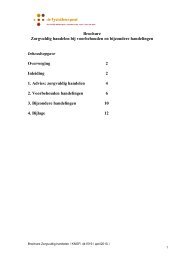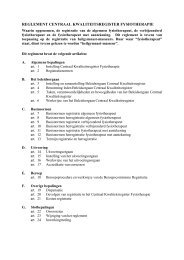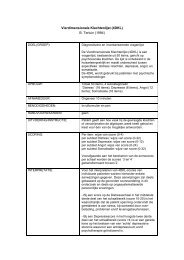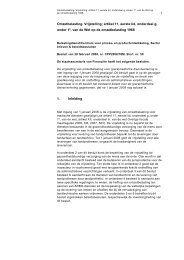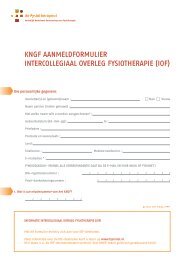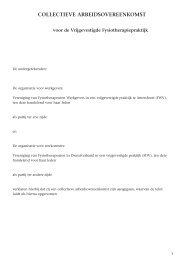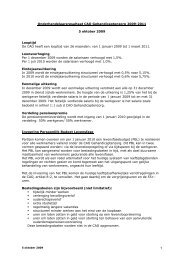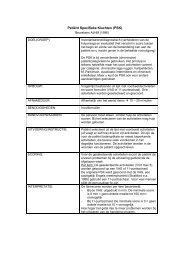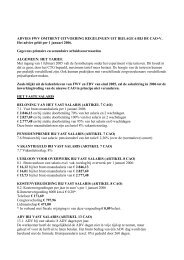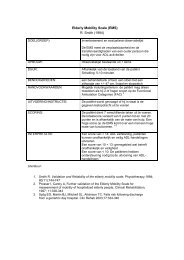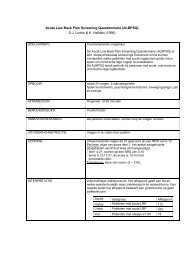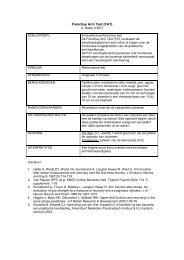Acupuncture and dry-needling for low back pain (Review)
Acupuncture and dry-needling for low back pain (Review)
Acupuncture and dry-needling for low back pain (Review)
Create successful ePaper yourself
Turn your PDF publications into a flip-book with our unique Google optimized e-Paper software.
Table 1. Criteria <strong>for</strong> the Risk of Bias Assessment<br />
(Continued)<br />
F. Was the outcome assessor blinded to the intervention? F. The reviewer determines if enough in<strong>for</strong>mation about the blinding<br />
is given in order to score a “yes.”<br />
G. Were cointerventions avoided or similar? G. Cointerventions should either be avoided in the trial design or<br />
similar between the index <strong>and</strong> control groups<br />
H. Was the compliance acceptable in all groups? H. The reviewer determines if the compliance to the interventions<br />
is acceptable, based on the reported intensity, duration, number<br />
<strong>and</strong> frequency of sessions <strong>for</strong> both the index intervention <strong>and</strong><br />
control intervention(s)<br />
I. Was the drop-out rate described <strong>and</strong> acceptable? I. The number of participants who were included in the study but<br />
did not complete the observation period or were not included in<br />
the analysis must be described <strong>and</strong> reasons given. If the percentage<br />
of withdrawals <strong>and</strong> drop-outs does not exceed 20% <strong>for</strong> immediate<br />
<strong>and</strong> short-term fol<strong>low</strong>-ups, 30% <strong>for</strong> intermediate <strong>and</strong> long-term<br />
fol<strong>low</strong>-ups <strong>and</strong> does not lead to substantial bias a “yes” is scored<br />
J. Was the timing of the outcome assessment in all groups similar? J. Timing of outcome assessment should be identical <strong>for</strong> all intervention<br />
groups <strong>and</strong> <strong>for</strong> all important outcome assessments<br />
K. Did the analysis include an intention-to-treat analysis? K. All r<strong>and</strong>omized patients are reported/analyzed in the group<br />
they were allocated to by r<strong>and</strong>omization <strong>for</strong> the most important<br />
moments of effect measurement (minus missing values) irrespective<br />
of noncompliance <strong>and</strong> cointerventions<br />
Table 2. Methodological quality assessment<br />
Study A <strong>and</strong> B C D, E <strong>and</strong> F G H I J K Comments, flaws, etc<br />
Araki 2001 Y <strong>and</strong> Y Y Y, N, Y Y Y Y Y Y Score=10 <strong>and</strong> no serious flaws<br />
(High)<br />
Carlsson<br />
2001<br />
Y <strong>and</strong> Y DK Y, N, Y DK DK Y (1 month)<br />
; N (3 <strong>and</strong> 6<br />
months)<br />
Y Y Score=7 at 1 month (fol<strong>low</strong>-up=<br />
100%), Score=6 at 3 <strong>and</strong> 6 months<br />
(fol<strong>low</strong>-up=64% <strong>and</strong> 54% respectively)<br />
(High)<br />
Ceccherelli<br />
2002<br />
Cherkin<br />
2001<br />
Y <strong>and</strong> DK Y DK, N, Y DK DK Y Y Y Score=6. No serious flaws. (High)<br />
Y <strong>and</strong> DK Y N, N, Y Y Y Y Y Y Score=8. No serious flaws (High)<br />
Coan 1980 Y <strong>and</strong> Y DK N, N, N DK N N N N Score=2 (Low)<br />
<strong>Acupuncture</strong> <strong>and</strong> <strong>dry</strong>-<strong>needling</strong> <strong>for</strong> <strong>low</strong> <strong>back</strong> <strong>pain</strong> (<strong>Review</strong>)<br />
Copyright © 2011 The Cochrane Collaboration. Published by John Wiley & Sons, Ltd.<br />
116



